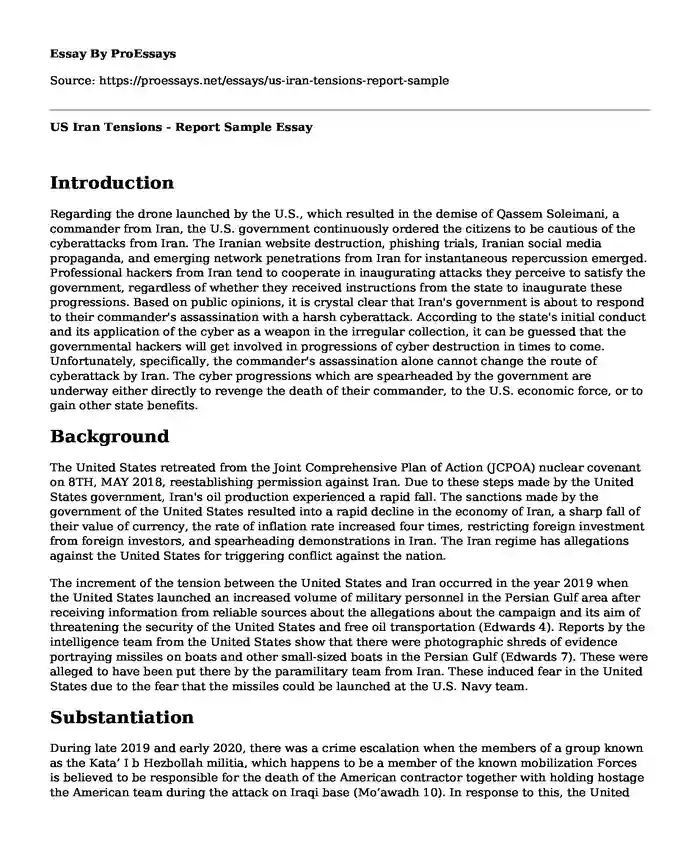Introduction
Regarding the drone launched by the U.S., which resulted in the demise of Qassem Soleimani, a commander from Iran, the U.S. government continuously ordered the citizens to be cautious of the cyberattacks from Iran. The Iranian website destruction, phishing trials, Iranian social media propaganda, and emerging network penetrations from Iran for instantaneous repercussion emerged. Professional hackers from Iran tend to cooperate in inaugurating attacks they perceive to satisfy the government, regardless of whether they received instructions from the state to inaugurate these progressions. Based on public opinions, it is crystal clear that Iran's government is about to respond to their commander's assassination with a harsh cyberattack. According to the state's initial conduct and its application of the cyber as a weapon in the irregular collection, it can be guessed that the governmental hackers will get involved in progressions of cyber destruction in times to come. Unfortunately, specifically, the commander's assassination alone cannot change the route of cyberattack by Iran. The cyber progressions which are spearheaded by the government are underway either directly to revenge the death of their commander, to the U.S. economic force, or to gain other state benefits.
Background
The United States retreated from the Joint Comprehensive Plan of Action (JCPOA) nuclear covenant on 8TH, MAY 2018, reestablishing permission against Iran. Due to these steps made by the United States government, Iran's oil production experienced a rapid fall. The sanctions made by the government of the United States resulted into a rapid decline in the economy of Iran, a sharp fall of their value of currency, the rate of inflation rate increased four times, restricting foreign investment from foreign investors, and spearheading demonstrations in Iran. The Iran regime has allegations against the United States for triggering conflict against the nation.
The increment of the tension between the United States and Iran occurred in the year 2019 when the United States launched an increased volume of military personnel in the Persian Gulf area after receiving information from reliable sources about the allegations about the campaign and its aim of threatening the security of the United States and free oil transportation (Edwards 4). Reports by the intelligence team from the United States show that there were photographic shreds of evidence portraying missiles on boats and other small-sized boats in the Persian Gulf (Edwards 7). These were alleged to have been put there by the paramilitary team from Iran. These induced fear in the United States due to the fear that the missiles could be launched at the U.S. Navy team.
Substantiation
During late 2019 and early 2020, there was a crime escalation when the members of a group known as the Kata’ I b Hezbollah militia, which happens to be a member of the known mobilization Forces is believed to be responsible for the death of the American contractor together with holding hostage the American team during the attack on Iraqi base (Mo’awadh 10). In response to this, the United States launched demos against the equipment believed to belong to Hezbollah in both Syria and Iraq, terminating over twenty members of the militia.
On the other hand, Hezbollah decided to launch an attack on the American embassy, which was located in Baghdad, as a reply to the message sent to him by the United States (Edwards 3). The message made the United States send over a hundred soldiers to the Middle East and declared that it would deal with Iran delegates located in Iraq. After a couple of days, both the commanders of IRGC and PMF were assassinated during the United States drone demos. The act resulted into a command by the main leader in Iran for resolution to revenge on the U.S. forces (Aggelaki 8). The two countries were almost having open warfare by early 2020 when U.S./Iraqi military camps faced missile attacks from IRGC, who claimed to be the revenge of Soleimani. Such an attack happened for the first time between the two countries, and it almost spearheaded war between the two (Edwards 5).
Conclusion
The tension that has been between the two countries, the United States and Iran, over the cyber-attack between each other has been due to the drawn demo which was launched by the U.S. and resulted in the death of Iran commander. The attack made the U.S. government feel suspicious that Iran would respond to this by launching a cyber-attack on the U.S., and they had to warn the citizens to be careful about this. Besides, the professional hackers from Iran had plans of working together with their government to facilitate this attack. However, the continuous attacks that have been occurring between the two nations are still on, and they almost entered into open warfare in early 2020.
Works Cited
Aggelaki, Cristina. Explaining international conflict escalation: a comparative analysis of the commercial aircraft shootdowns of MH17, KAL007, and IR655. M.S. thesis. University of Twente, 2020.
Edwards, Scott. "Al Jazeera Centre for Studies US-Iran tensions: East Asian Perspectives."
Mo’awadh, Ali Jalal. "THE FUTURE OF IRAN’S REGIONAL ROLE AND THE ARAB WORLD’S OPTIONS."
Cite this page
US Iran Tensions - Report Sample. (2024, Jan 06). Retrieved from https://proessays.net/essays/us-iran-tensions-report-sample
If you are the original author of this essay and no longer wish to have it published on the ProEssays website, please click below to request its removal:
- A Critical Review of the Book National Identities by Anthony Smith
- American Way of War Essay
- Realists and Liberalists Views on Conflict Essay
- Essay Sample on Curriculum Relevance in Multicultural Societies: Standardizing Knowledge
- Paper Example on U.S. vs. Canada: Comparing Health Care Cost and Quality
- Essay on Rising Floods in Canada: Spending Soars as Disaster Strikes More Frequently
- Essay Sample on The Internet: Blessing or Curse







